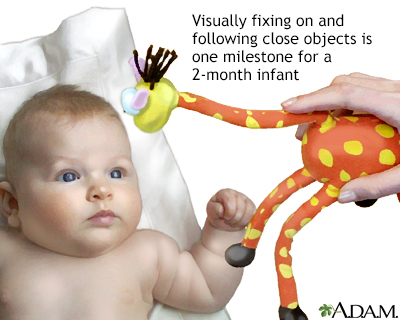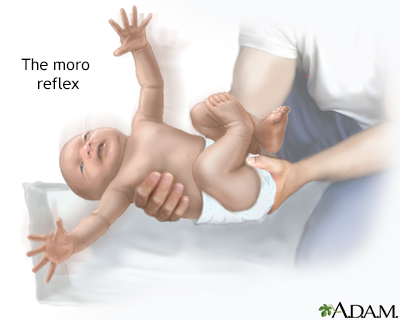Infant - newborn development
Images




Information
Infant development is most often divided into the following areas:
- Cognitive
- Language
- Physical, such as fine motor skills (holding a spoon, pincer grasp) and gross motor skills (head control, sitting, and walking)
- Social
PHYSICAL DEVELOPMENT
An infant's physical development begins at the head, then moves to other parts of the body. For example, sucking comes before sitting, which comes before walking.
Newborn to 2 months:
- Can lift and turn their head when lying on their back
- Hands are fisted, the arms are flexed
- Neck is unable to support the head when the infant is pulled to a sitting position
Primitive reflexes include:
- Babinski reflex, toes fan outward when sole of foot is stroked
- Moro reflex (startle reflex), extends arms then bends and pulls them in toward body with a brief cry; often triggered by loud sounds or sudden movements
- Palmar hand grasp, infant closes hand and "grips" your finger
- Placing, leg extends when sole of foot is touched
- Plantar grasp, infant flexes the toes and forefoot
- Rooting and sucking, turns head in search of nipple when cheek is touched and begins to suck when nipple touches lips
- Stepping and walking, takes brisk steps when both feet are placed on a surface, with body supported
- Tonic neck response, left arm extends when infant gazes to the left, while right arm and leg flex inward, and vice versa
3 to 4 months:
- Better eye-muscle control allows the infant to track objects.
- Begins to control hand and feet actions, but these movements are not fine-tuned. The infant may begin to use both hands, working together, to accomplish tasks. The infant is still unable to coordinate the grasp, but swipes at objects to bring them closer.
- Increased vision allows the infant to tell objects apart from backgrounds with very little contrast (such as a button on a blouse of the same color).
- Infant raises up (upper torso, shoulders, and head) with arms when lying face down (on tummy).
- Neck muscles are developed enough to allow the infant to sit with support, and keep head up.
- Primitive reflexes have either already disappeared, or are starting to disappear.
5 to 6 months:
- Able to sit alone, without support, for only moments at first, and then for up to 30 seconds or more.
- Infant begins to grasp blocks or cubes using the ulnar-palmar grasp technique (pressing the block into palm of hand while flexing or bending wrist in) but does not yet use thumb.
- Infant rolls from back to stomach. When on tummy, the infant can push up with arms to raise the shoulders and head and look around or reach for objects.
6 to 9 months:
- Crawling may begin
- Infant can walk while holding an adult's hand
- Infant is able to sit steadily, without support, for long periods of time
- Infant learns to sit down from a standing position
- Infant may pull into and keep a standing position while holding onto furniture
9 to 12 months:
- Infant begins to balance while standing alone
- Infant takes steps holding a hand; may take few steps alone
SENSORY DEVELOPMENT
- Hearing begins before birth, and is mature at birth. The infant prefers the human voice.
- Touch, taste, and smell, mature at birth; prefers sweet taste.
- Vision, the newborn infant can see within a range of 8 to 12 inches (20 to 30 centimeters). Color vision develops between 4 to 6 months. By 2 months, can track moving objects up to 180 degrees, and prefers faces.
- Inner ear (vestibular) senses, the infant responds to rocking and changes of position.
LANGUAGE DEVELOPMENT
Crying is a very important way to communicate. By the baby's third day of life, mothers can tell their own baby's cry from that of other babies. By the first month of life, most parents can tell if their baby's cry means hunger, pain, or anger. Crying also causes a nursing mother's milk to letdown (fill the breast).
The amount of crying in the first 3 months varies in a healthy infant, from 1 to 3 hours a day. Infants who cry more than 3 hours a day are often described as having colic. Colic in infants is rarely due to a problem with the body. In most cases, it stops by 4 months of age.
Regardless of the cause, excessive crying needs a medical evaluation. It can cause family stress that can lead to child abuse.
0 to 2 months:
- Alert to voices
- Uses range of noises to signal needs, such as hunger or pain
2 to 4 months:
- Coos
4 to 6 months:
- Makes vowel sounds ("oo," "ah")
6 to 9 months:
- Babbles
- Blows bubbles ("raspberries")
- Laughs
9 to 12 months:
- Imitates some sounds
- Says "Mama" and "Dada,", but not specifically for those parents
- Responds to simple verbal commands, such as "no"
BEHAVIOR
Newborn behavior is based on six states of consciousness:
- Active crying
- Active sleep
- Drowsy waking
- Fussing
- Quiet alert
- Quiet sleep
Healthy babies with a normal nervous system can move smoothly from one state to another. Heart rate, breathing, muscle tone, and body movements are different in each state.
Many bodily functions are not stable in the first months after birth. This is normal and differs from infant to infant. Stress and stimulation can affect:
Periodic breathing, in which breathing starts and stops again, is normal. It is not a sign of sudden infant death syndrome (SIDS). Some infants will vomit or spit up after each feeding, but have nothing physically wrong with them. They continue to gain weight and develop normally.
Other infants grunt and groan while making a bowel movement, but produce soft, blood-free stools, and their growth and feeding are good. This is due to immature abdominal muscles used for pushing and does not need to be treated.
Sleep/wake cycles vary, and do not stabilize until a baby is 3 months old. These cycles occur in random intervals of 30 to 50 minutes at birth. Intervals gradually increase as the infant matures. By age 4 months, most infants will have one 5-hour period of uninterrupted sleep per day.
Breast-fed infants will feed about every 2 hours. Formula-fed infants should be able to go 3 hours between feedings. During periods of rapid growth, they may feed more often.
You do not need to give water to a baby. In fact, it could be dangerous. An infant who is drinking enough will produce 6 to 8 wet diapers in a 24-hour period. Teaching the infant to suck a pacifier or their own thumb provides comfort between feedings.
SAFETY
Safety is very important for infants. Base safety measures on the child's developmental stage. For example, around age 4 to 6 months, the infant may begin to roll over. Therefore, be very careful while the baby is on the changing table.
Consider the following important safety tips:
- Be aware of poisons (household cleaners, cosmetics, medicines, and even some plants) in your home and keep them out of your infant's reach. Use drawer and cupboard safety latches. Post the national poison control number -- 1-800-222-1222 -- near the phone.
- DO NOT allow older infants to crawl or walk around in the kitchen while adults or older siblings are cooking. Block the kitchen off with a gate or place the infant in a playpen, highchair, or crib while others cook.
- DO NOT drink or carry anything hot while holding the infant to avoid burns. Infants begin waving their arms and grabbing for objects at 3 to 5 months.
- DO NOT leave an infant alone with siblings or pets. Even older siblings may not be ready to handle an emergency if it occurs. Pets, even though they may appear to be gentle and loving, may react unexpectedly to an infant's cries or grabs, or may smother an infant by lying too closely.
- DO NOT leave an infant alone on a surface from which the child can wiggle or roll over and fall off.
- For the first 5 months of life, always place your infant on their back to go to sleep. This position has been shown to reduce the risk for sudden infant death syndrome (SIDS). Once a baby can roll over by himself, the maturing nervous system greatly reduces the risk for SIDS.
- Know how to handle a choking emergency in an infant by taking a certified course through the American Heart Association, the American Red Cross, or a local hospital.
- Never leave small objects within an infant's reach, infants explore their environment by putting everything they can get their hands on into their mouth.
- Place your infant in a proper car seat for every car ride, no matter how short the distance. Use a car seat that faces backward until the infant is at least 1 year old AND weighs 20 pounds (9 kilograms), or longer if possible. Then you can safely switch to a forward facing car seat. The safest place for the infant's car seat is in the middle of the back seat. It is very important for the driver to pay attention to driving, not playing with the infant. If you need to tend to the infant, safely pull the car over to the shoulder and park before trying to help the child.
- Use gates on stairways, and block off rooms that are not "child proof." Remember, infants may learn to crawl or scoot as early as 6 months.
CONTACT YOUR HEALTH CARE PROVIDER IF:
- The infant does not look good, looks different from normal, or cannot be consoled by holding, rocking, or cuddling.
- The infant's growth or development does not appear normal.
- Your infant seems to be "losing" developmental milestones. For example, if your 9-month-old was able to pull to standing, but at 12 months is no longer able to sit unsupported.
- You are concerned at any time.
References
Onigbanjo MT, Feigelman S. The first year. In: Kliegman RM, St. Geme JW, Blum NJ, Shah SS, Tasker RC, Wilson KM eds. Nelson Textbook of Pediatrics. 21st ed. Philadelphia, PA: Elsevier; 2020:chap 22.
Olsson JM. The newborn. In: Kliegman RM, St. Geme JW, Blum NJ, Shah SS, Tasker RC, Wilson KM, eds. Nelson Textbook of Pediatrics. 21st ed. Philadelphia, PA: Elsevier; 2020:chap 21.
BACK TO TOPReview Date: 1/24/2023
Reviewed By: Neil K. Kaneshiro, MD, MHA, Clinical Professor of Pediatrics, University of Washington School of Medicine, Seattle, WA. Also reviewed by David C. Dugdale, MD, Medical Director, Brenda Conaway, Editorial Director, and the A.D.A.M. Editorial team.

Health Content Provider
06/01/2025
|
A.D.A.M., Inc. is accredited by URAC, for Health Content Provider (www.urac.org). URAC's accreditation program is an independent audit to verify that A.D.A.M. follows rigorous standards of quality and accountability. A.D.A.M. is among the first to achieve this important distinction for online health information and services. Learn more about A.D.A.M.'s editorial policy, editorial process and privacy policy. A.D.A.M. is also a founding member of Hi-Ethics. This site complied with the HONcode standard for trustworthy health information from 1995 to 2022, after which HON (Health On the Net, a not-for-profit organization that promoted transparent and reliable health information online) was discontinued. |
The information provided herein should not be used during any medical emergency or for the diagnosis or treatment of any medical condition. A licensed medical professional should be consulted for diagnosis and treatment of any and all medical conditions. Links to other sites are provided for information only -- they do not constitute endorsements of those other sites. © 1997- 2024 A.D.A.M., a business unit of Ebix, Inc. Any duplication or distribution of the information contained herein is strictly prohibited.
